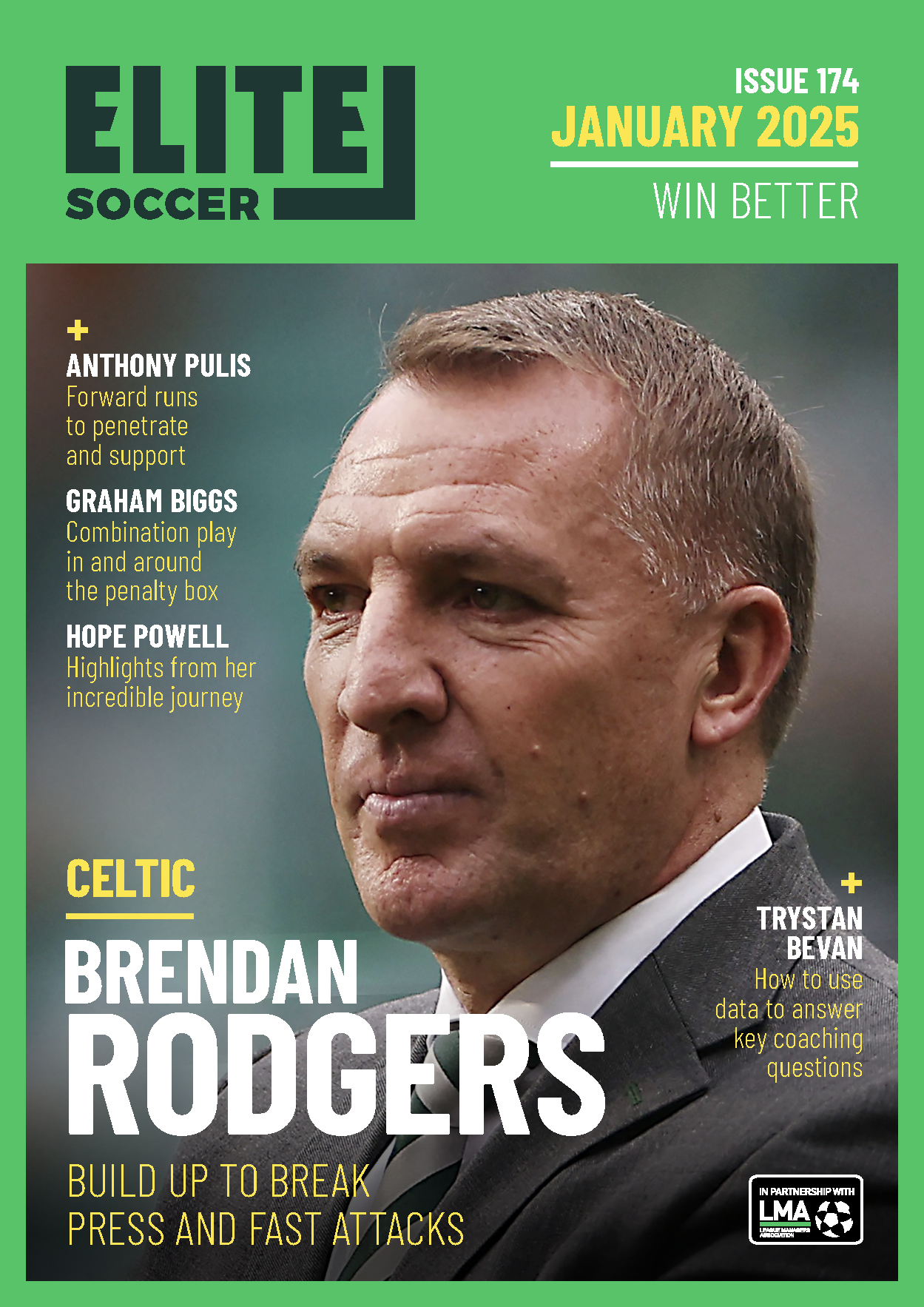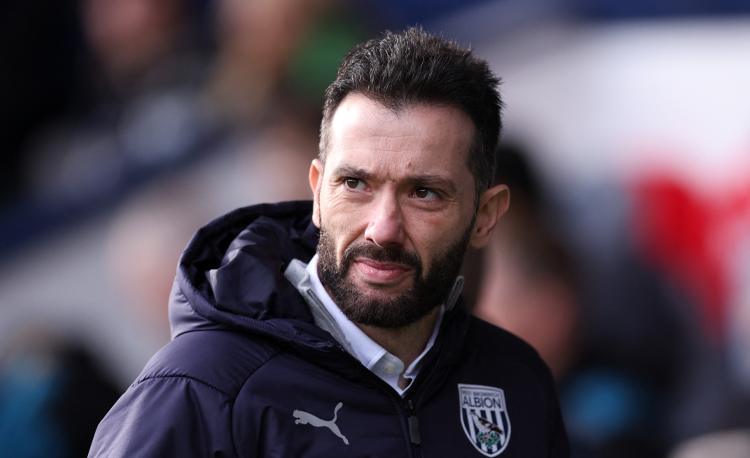You are viewing 1 of your 1 free articles
Passing on the half turn
| Area | Up to half a pitch |
| Equipment | Balls, bibs, cones, 2 full-size goals |
| No. of Players | Up to 12 players + 2 goalkeepers |
| Session Time | Passing boxes: 45secs each, Passing with a finish: 30mins |
I first saw this session when I was on a club visit to NAC Breda in Holland. It was focused on body shape and the way the players not only received the pass but on getting the pass to the back foot and with the correct weight.
The session begins with an appropriate series of warm-up activities, but the primary focus of the coaching work in the main session is on the midfield players who receive the ball in the 20x20-yard square. The coaches wanted players to get in the habit of constantly checking over their shoulders before receiving a pass. They also wanted them to play on the half-turn, moving the ball with a maximum of two touches and putting the right weight on the ball so that the next player could play a one-touch pass.
I have used this drill at academy level and with the first team, and both age groups enjoy the session enormously. It’s a really fast-moving exercise that ends with a pass and finish. It also works both sides of the pitch simultaneously, enabling both a right and a left foot finish.
The drill is physically demanding so allow a break.
What do I get the players to do?
Passing box 1
We start with a series of four passing boxes, set up in an area of 10x10 yards. We’re using six players. For the first box, two players are positioned at the starting corner, one player begins in the centre, and one player starts on each of the three remaining corners. It’s pass and move, so players must always follow their pass to the next station.
Player 1 starts the warm-up at the bottom left-hand corner by passing to player 2 in the centre. Player 2 receives the ball on the half-turn and spins round to pass it to the top right corner. The ball is received by player 3, who passes to player 1, who is now in the centre. Player 1 receives on the half-turn and changes direction by passing to the bottom right-hand corner of the box, as shown [1].
1
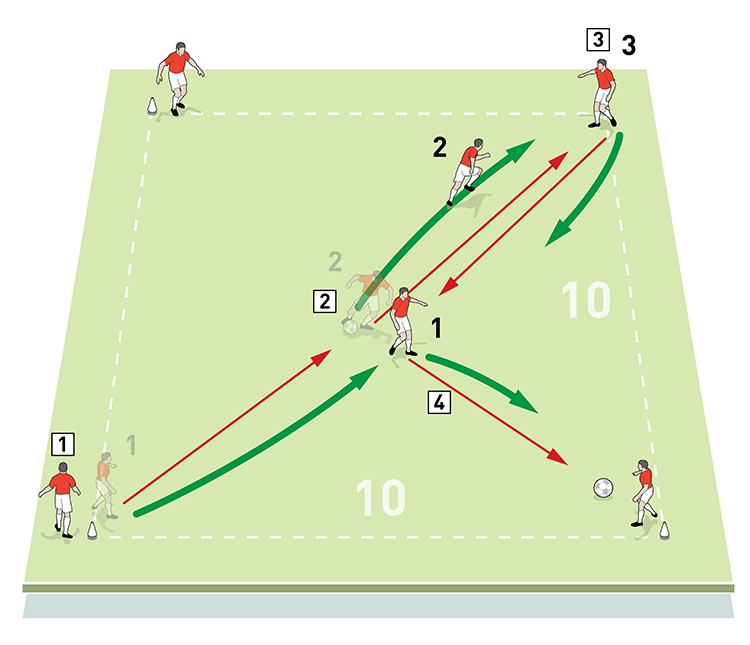
2. Player 2 receives on the half-turn and spins round to make the next pass to player 3
3. Player 3 passes one-touch to player 1, who is now in the centre
4. Player 1 receives on the half-turn and changes direction with his next pass. Play then continues around the box in the same manner
Play continues following this pattern. Play for 45 seconds.
Passing box 2
Using the same set-up, players follow a simple, repeated passing sequence: one pass along the edge of the box, followed by a pass into the centre and out again.
Play starts from the corner with two players. Pass 1 is played along the bottom side of the box and pass 2 is played into the central man, who opens his body to receive and plays the ball out to the next corner, as shown [2]. Pass 4 is played along the top side of the box, before the receiver returns the ball to the centre. From there it is played back to the starting point.
2
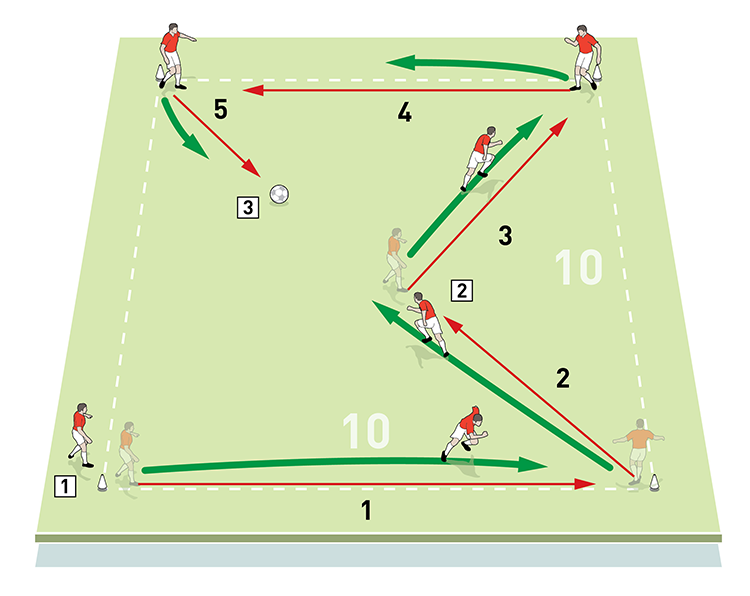
2. The ball is played into the centre and out again
3. Pass 4 is played along the top side before the ball is returned to the centre with pass 5. Play continues following the same pattern
Play for 45 seconds, following the same pattern. The players always follow their pass.
Passing box 3
Using the same set-up, play starts with passes along the first two sides before a pass is made into the centre and out again, as shown [3]. Then a pass is made down the final side, before the ball starts again on the same route around the box, with the players always following their pass. Play for 45 seconds.
3

2. The third pass is played into the central player and out again
3. Once the circuit is completed with a final pass down the side, play continues around the box following the same pattern
Passing box 4
The final passing box uses the same set-up, this time with two passes along the side followed by a pass into the centre and out again. A second pass into the centre and out again takes the ball back to the starting point, as shown [4]. Continue this passing routine for 45 seconds.
4
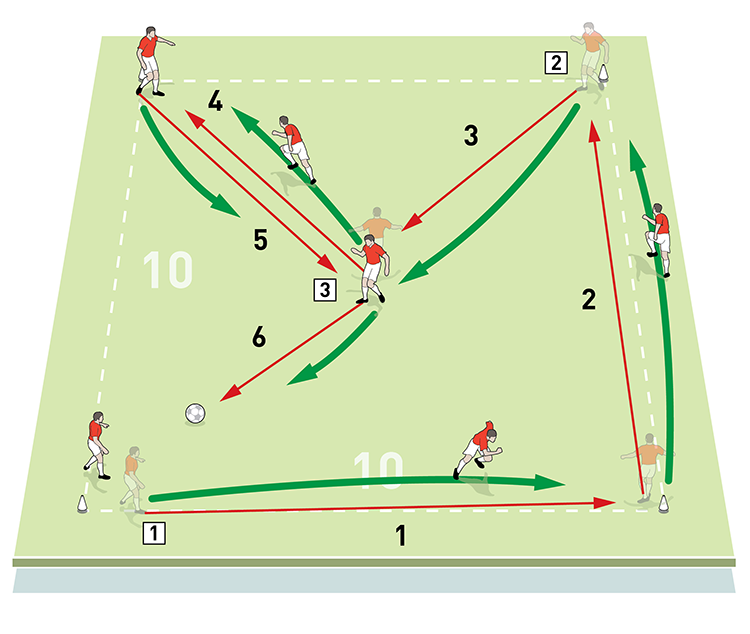
2. Pass 3 is played into the central player who receives and plays the ball out to the next corner
3. The ball is played into the centre and out again with passes 5 and 6, completing the circuit. Play for 45 seconds
What do I get the players to do next?
Passing with a finish
This passing drill is aimed at creating situations where the midfield players receive passes on the half-turn and then move the ball on. We set up on half a pitch, with a 20x20-yard square marked out five yards in front of the penalty area. Position a goal either side of the penalty area on the by-line. We’re using 12 outfield players and two goalkeepers, starting as shown [5a].
The same drill is run simultaneously on both sides of the pitch. Player 1 starts the right-hand attack with a pass into player 2 in the centre of the square, as shown [5b]. Player 2 receives on the half-turn and spins round, playing a pass to player 3, who has timed his run to clip the ball first time to player 4 on the corner of the penalty area. Player 4 has also timed his run from the edge of the six-yard box to meet the ball and he sets it for the oncoming player 3 to finish with a shot on goal.
Players should all move to new starting positions after making their contributions: player 1 replaces 2 in the square; player 2 replaces 3; player 3 replaces 4; and player 4 replaces player 5 at the starting position for the other half of the drill. All players will eventually complete both the left-hand and the right-hand sequences.
We would play this for 30 minutes.
5a
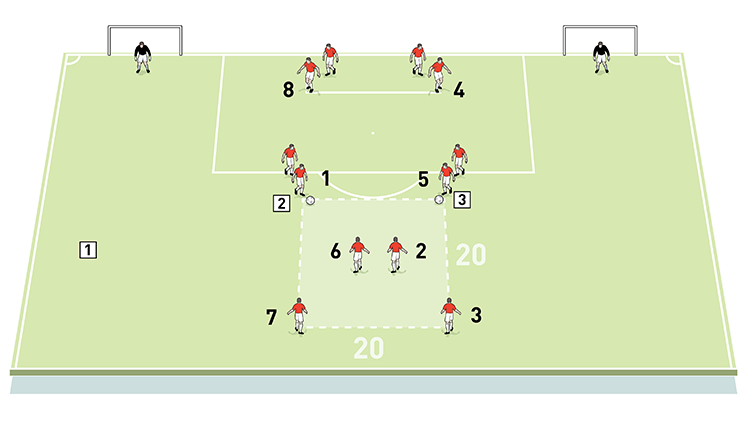
2. Player 1 is the starting player for the drill on the right-hand side of the pitch
3. Player 5 is the starting player for the drill on the left-hand side of the pitch
5b
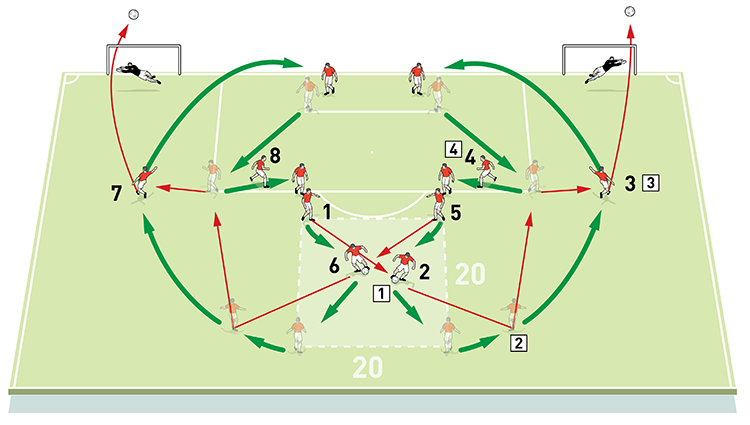
2. Player 3 times his run to meet the pass and fires the ball first time up to the edge of the penalty area, where 4 runs to receive
3. Player 4 sets the ball for the onrushing player 3 to take a shot at goal
4.Players move on to new starting positions. Here player 4 moves to replace 5 and will soon start the drill on the other side of the pitch
What are the key things to look out for?
We want to see players understanding the body shape needed to receive on the half-turn, which is the cornerstone of this session. Players should let the ball come across their body and must receive on their back foot, which allows them to control the ball while turning.
Although these activities are unopposed, we also want to see players getting in the habit of checking over both shoulders so they can be aware of potential opponents closing in ready to steal the ball.
Related Files
Editor's Picks
Using the goalkeeper in build-up play
Pressing principles
Intensive boxes drill with goals
Penetrating the final third
Creating and finishing
My philosophy
Pressing initiation
Compact team movement
Defensive organisation
Coaches' Testimonials

Alan Pardew

Arsène Wenger

Brendan Rodgers

Carlos Carvalhal

José Mourinho

Jürgen Klopp

Pep Guardiola

Roy Hodgson

Sir Alex Ferguson

Steven Gerrard
Coaches' Testimonials

Gerald Kearney, Downtown Las Vegas Soccer Club

Paul Butler, Florida, USA

Rick Shields, Springboro, USA

Tony Green, Pierrefonds Titans, Quebec, Canada
Join the world's leading coaches and managers and discover for yourself one of the best kept secrets in coaching. No other training tool on the planet is written or read by the calibre of names you’ll find in Elite Soccer.
In a recent survey 92% of subscribers said Elite Soccer makes them more confident, 89% said it makes them a more effective coach and 91% said it makes them more inspired.
Get Monthly Inspiration
All the latest techniques and approaches
Since 2010 Elite Soccer has given subscribers exclusive insight into the training ground practices of the world’s best coaches. Published in partnership with the League Managers Association we have unparalleled access to the leading lights in the English leagues, as well as a host of international managers.
Elite Soccer exclusively features sessions written by the coaches themselves. There are no observed sessions and no sessions “in the style of”, just first-hand advice delivered direct to you from the coach.



